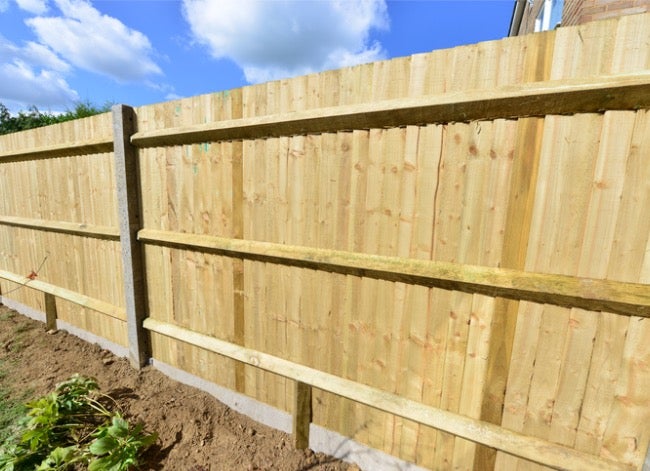
istockphoto.com
Having a fence up around the yard gives the home a number of advantages, including increased privacy, security, and safety. In fact, in some locations, a fence is mandatory if the home has a pool, so it’s important that the fence is strong and sturdy in order to support any weight applied to it, like a person leaning, and to resist heavy winds that may otherwise blow it down.
If the fence panels or posts begin to show signs of damage, like splintering, cracking, or rotting, then it’s time to decide whether a quick fix approach can help resolve the issue or if the entire post needs to be removed and repaired. Fence post repair isn’t overly complicated, but if the repair isn’t thoroughly completed then the same issue can quickly arise once more.
1. Assess the damaged post carefully.
Before deciding whether to repair or replace a fence post it is important to examine the post, the damage, and any underlying causes that are affecting the fence post. The reason to take a look at the non-damaged part of the post is to help determine the current quality of the wood. If the entire fence post is just a year or two away from needing to be replaced, then it would make more sense to complete the replacement immediately instead of repairing it.
Assess the damage and decide whether it’s acute damage, like that caused by a neighbor backing into the fence, or chronic damage that will continue to get worse if the problem isn’t resolved, like wood rot. Typically, acute damage is worth repairing, but chronic damage is likely to reoccur, so it’s only worth repairing if the underlying causes, like excess moisture or insect infestations, can be alleviated.
2. Alleviate the root of the problem.
Fence posts won’t generally break down on their own unless the fence has been in the ground for more than 20 years, and even then most of the deterioration can be attributed to the combined effects of UV radiation and precipitation. So, if a fence post is showing signs of damage, then it’s imperative that the underlying cause is discovered and stopped or at least alleviated, otherwise the damage will continue even if the fence is repaired.
Common factors that can contribute to ongoing damage include highly acidic concrete footings, moisture traps that collect rainwater at the base of the fence post, and insect infestations, like carpenter ants, termites, and powderpost beetles.
RELATED: How to Fix a Leaning Fence

istockphoto.com
3. A quick-fix product could do the trick.
In cases of acute damage or even mild chronic damage where the underlying factor has been treated and alleviated, a quick-fix fence repair product may be the right option. These products are designed to fix cracks and breaks in the fence post without having to completely replace the post.
Depending on the severity of the damage, a fence patch kit may be the best option. These kits are impact- and UV-resistant, helping to fix holes, small cracks, and minor damage. For more serious issues, consider fence post brackets and ground spikes that can be driven down through the concrete footing and attached to the post to create a secure base for the fence post.
4. To swap out an entire fence post, first separate it from the rest of the fence.
After assessing the damage to the fence post, you may discover that the post is beyond repair, at which point the entire post will need to be replaced. Before removing the fence post, make sure that you have a replacement post, as well as the necessary material to install it, including brackets, screws, gravel, concrete mix, a bucket or wheelbarrow, a shovel, a level, and possibly a posthole digger.
With these items ready, the fence post can be separated from the rest of the fence by removing the screws or nails and the brackets that hold one or more fence pieces to the post. Just make sure that supports are used to ensure the fence pieces don’t collapse and tear away from the rest of the fence while completing the post replacement.
5. Removing the concrete footing is labor-intensive, but necessary.
The concrete footing is the solid mass of concrete buried deep in the ground at the base of the post. This footing supports the weight of the post and the attached fence, preventing it from twisting, pulling, and leaning when weight is applied to the fence or the fence is hit with heavy winds. However, when replacing a fence post, the concrete footing also needs to be removed.
The reason for this is that the new fence post needs to be able to occupy the same space as the old post in order to properly support the existing fence instead of putting strain on the structure. Unfortunately, this isn’t an easy task. DIYers will need to dig down to the concrete footing, uncovering it enough so that the block can be hauled up and out of the ground. Consider using a sledgehammer or a jackhammer to break the concrete into smaller pieces to make the job easier.

istockphoto.com
RELATED: The Most Affordable Ways to Fence a Yard
6. Ensure proper footing depth for the replacement fence post.
While removing the concrete footing is a labor-intensive task, the good news is that the hole doesn’t need to be dug twice, so you just need to make sure that it’s at the right depth to create a proper footing for the replacement fence post. Typically, ⅓ to ½ of the fence post should be able to sit comfortably in the hole with an additional 6 inches of depth that will be filled with gravel to help ensure proper drainage.
However, if the fence post is being installed in a location that experiences freezing temperatures, then it will need to be set deep enough to sit below the frost line. On average the frost line for most areas is about 3 feet down, so an appropriate minimum depth would be about 4 feet, but keep in mind that some locations may have a frost line up to 8 feet in depth. Also, ensure that the fence post is level and plumb so that it doesn’t cause strain on the rest of the fence once installed.
7. Finishing touches.
To finish the replacement, add gravel to the hole and tamp it down to create a tightly packed, supportive base and then lower the fence post into the hole, making sure that it is centered in the hole, in line with the other posts, plumb, and level. Hold the post in the right position with one or more stakes, then mix the concrete in a bucket or a wheelbarrow.
When the concrete is properly mixed, begin shoveling it into the hole, surrounding the post with concrete. Leave a few inches at the top of the hole for soil if you want the grass to grow around the post, or fill it completely if you prefer to see the concrete base. Allow about three days for the concrete to cure, then reattach the fence pieces to the fence post with new brackets and screws. Finalize the repair by staining the fence post to protect it from UV radiation and water damage.

istockphoto.com
source: https://www.bobvila.com/articles/fence-post-repair/

